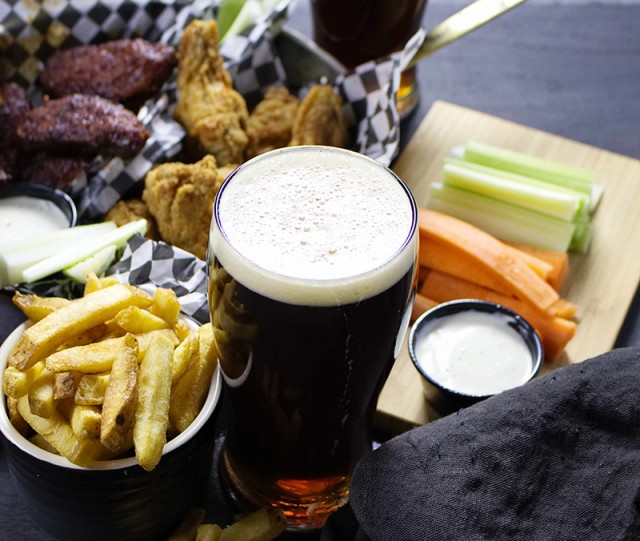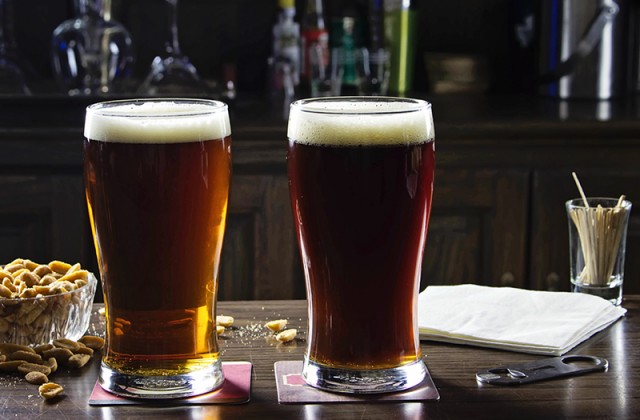If you're a beer enthusiast, have you ever considered home brewing? As Jared Kovacs tells us, a good way to start out is to try duplicating some of your favourite commercial beers. In his introductory article to home brewing, Jared shares his recipe for an Irish Red Ale that he likes even more than his favourite commercial version.
Beer is community. The first beer I ever had I was surrounded by friends, as was my most recent. I bet yours was too. Everything about the beverage is permeated by its communal consumption. I started to brew my own beer the same way I began to drink it, surrounded by enthusiastic friends. I still remember the day they showed me how. We spent the afternoon drinking beer while brewing, apparently a brewer’s superstition, and by the end of the day I was hooked. That same week I bought all the essential equipment: carboys, brewing pot, bottling wand, bottles and a bottling bucket.
One of the things I love about brewing is that it can be as simple or as complicated as you want it to be. It’s like the ocean: shallow enough to wade in but its depths will keep you exploring. Simply said, there’s always something new to discover, whether that be a new beer style, acquiring new equipment, or brewing technique. The sky’s the limit! I’m not kidding — you can brew with mushrooms and spruce tips!
It’s also deeply satisfying, regardless if you’re a beginner or expert. The feeling of accomplishment after taking the first sip of your most recent brew can be overwhelming. For me, I typically start jumping up and down yelling, “I made that! I MADE THAT!” while beer flies across the room. I know, I know! Way. Too. Excited. The satisfaction only intensifies as you share your beer with friends and family. Their reactions, both positive and negative, will inspire you to get better at your craft.
When first starting out, I recommend trying to duplicate (clone) beers you love. That way you have something to judge your home brews against. We don’t all have a local home brew club to help us judge our brews, so making clone recipes totally helps you to know if you’re on the right track.
I love Irish Red Ales and have spent the majority of my time learning about what makes this style of beer so amazing. The first Irish Red Ale I had was a popular brew from one of the Big Beer Companies (BBC). Its copper red colour and caramel malt flavour were so unique compared to the other beers available at the time. I was hooked.
As the craft beer industry has grown in recent years, so has my exposure to other Irish Reds. Since then I’ve tried countless Irish Reds from what seems like countless breweries. Many of them I’ve thought were delicious, but if I’m honest, I often find myself ordering that first commercial version over these craft brews — chalk it up to feelings of nostalgia. I think I just heard a collective gasp from my fellow home brewers and craft brew fanatics as I wrote that — “How dare you like a beer that’s produced by one of the BBCs?!”
That collective gasp can be intimidating, especially if you’re new to the world of beer. But don’t let it be. You wanna know why? Because almost everyone’s first beer came from a BBC. Don’t let the opinions of others direct your brewing, let your love of beer. You’ll find it way more satisfying and enjoyable if you stay true to yourself. Plus your friends and family will probably like it more. They’ll cheer you on!
How does my recipe compare to the actual thing? Well, I did my typical reaction. I yelled, “I made that! I MADE THAT!” while the first pint flew through the air. I’d say it was pretty close to perfect. I almost nailed that beautiful copper red colour. The only difference is that the commercial brew is much clearer than mine. I expected this as all mass-produced beer is filtered while my home brews aren’t. The taste is almost exactly the same as well.

I did a side by side taste test and, going from the original to mine, I hardly noticed a difference. It wasn’t until I tasted my recipe and then the commercial brew that I noticed a difference: the BBC's actually tasted watery. Again, not completely unexpected. All mass produced beer has adjunct grains like corn or rice. They don’t offer a lot of flavour but they do help to get their alcohol percentages. This is why so many people complain about BBC’s beer not tasting like anything! Finally, there was a significant difference in alcohol by volume (ABV). My clone recipe is quite a bit higher than the original version's 5.2 percent. If I did all the calculations right, my recipe is sitting at 7 percent.
Have I enticed you to brew? Have I convinced you to try this recipe? If so, here it is and let me know how it turned out!
Happy brewing — cheers!
- 8 pounds of Canadian 2 Row Brewers Malt
- 2 pounds of Munich Malt 10L
- 1 pound Caramel/Crystal Malt - 60L
- 2 ounces of Roasted Barley
- 2 ounces of East Kent Golding Hops
- 1 packet of Safale S-04 Dry Ale Yeast
- ¾ cup priming sugar (dextrose)
- Add all grains into your mash tun.
- Bring 3.3 gallons of water to 173Fº. Then add to mash tun. Make sure to stir grains to avoid from clumping together. Put lid on mash tun. Your mash water should now be around 152Fº. Hold for 60 minutes.
- Collect another 4.9 gallons of water and bring to 179Fº for upcoming infusions. Once 60 minutes is finished you need to sparge the grains with the water you just heated up. Transfer original mash to brew pot and begin to slowly add the 4.9 gallons of water.
- Once your sparge is finished bring the wort (unfermented beer) to a boil and hold for 60 minutes.
- Add 1 ounce of East Kent Goldings (bittering hops) once wort begins to boil.
- When there’s 5 minutes left in the boil add in the other 1 ounce of East Kent Goldings (aroma hops).
- Once you have boiled the wort for 60 minutes stop the boiling process. Begin to cool the wort immediately. At this point only sanitized equipment should touch the wort.
- Transfer the wort to carboy and pitch Safale Ale Yeast. Let ferment for approximately 2 weeks.
- Once the beer is finished fermenting it’s ready to be bottled or kegged.
- In a sanitized bottling bucket add ¾ cup of priming sugar (dextrose). Rack beer in bucket and with a sanitized stainless steel spoon stir to mix in sugar. Begin bottling. Use an empty pop bottle to use as your tester to know when the beer has properly carbonated. Once the bottle has reached the same firmness as an unopened pop bottle the beer is ready. Refrigerate and age for 21 days or enjoy as soon as it’s cold!
Home Brewing Tip
Where to get Equipment
There are a ton of starter kits available from online and local home brew shops. They’re cost effective and give you everything you need to start brewing great beer! If you’re on a tight budget, buy used equipment. Spend a Saturday perusing garage sales or get on Kijiji or VarageSale and see what you can find. People are always selling items — it’s worth it to look here first!
Have you brewed your own beer? If so, share your favourite recipe in the comments!
More Reading
Home Brewing: Make What You Love was written by Jared Kovacs. Jared comes from a long line of food and drink connoisseurs. His father was a chef, his grandparents owned a diner, his grandfather is a home brewer, and his great-great-great-grandfather was a brewmaster in Germany. He loves sharing good food, beer (especially home brews), and cider with friends and family. You can follow him at The Hesitant Chef or on social media at Facebook, Twitter, or Instagram.








Love the idea of making my own beer! Dangerous also… I could fall into it! The hardest part seams to be to find all those ingredients but for the process it seems quite easy! Great to know! Prost!
Hey Marie-Pierre,
Ingredients aren’t that hard to find! You can order them from multiple sites, but the one I like best is brewerpantry.com. They didn’t pay me to say that! I just like the owner, he’s super friendly and very helpful! I hope that helps!
Cheers,
Look at these profesh photos! These beers look dee-lish. They look like they have a really nice body to them! (This is me, thinking I know what I’m talking about.) Nick has been flirting with the idea of homebrewing, but he’s a procrastinator. I keep bugging him to get into it, and every time you post beers I’m like, “LOOK. LOOK AT WHAT YOU COULD BE DOING!” I even tried to cajole him with the idea that you can do fun flavors, like the pepper strawberry one you did!
Keep up the awesome work, homeboy.
Hey Dana, Thanks! I think Nick needs to get his act together and make some delicious homebrew already!
Congrats on a beautiful batch of homemade beer! I’ve never made any, but I can understand that feeling of “I made THAT!”. It’s a great feeling, one we need to feel more often. Pride beaming from our faces and being able to taste it is awesome! Good job!
I am not a beer lover…however hubby does like to try different beers. He never buys just regular beer, always micro brands. This sounds like one he would love. As for beer making, it looks like you totally enjoy your craft. Doing something you love is so rewarding.
Thanks Gloria! It is a great hobby! I mostly like sharing my latest creations with my family and friends. It’s a wonderful feeling knowing they enjoy my brews. It sounds like your husband would love homebrewing!
It’s been a while since we’ve home brewed (we started in university to cut down beer costs, lol) but we still have our equipment AND I just purchased a cascade hop rhizome, so looks like brewing will be in our future!
We have a very enthusiastic home brewing culture here in Calgary, and a local group called the YeastWranglers full of those very same enthusiasts. Hubby’s favourite style is Irish Red, so maybe I’ll encourage him to give this recipe a try. I’ll round up the ingredients for him for his birthday present next month!
Bernice! Having a local brew club is one of the best ways to learn to brew! The people that make them up are so helpful and awesome! It sounds like you have the beginning of a great IPA! Good luck and enjoy! Let me know how your recipe turns out and how you enjoyed this one!
Haha thanks, Kellie! It’s always good to hear from you! Get a starter kit and get making some delicious homebrew already! You won’t regret it!
I have brewed this twice now and it’s a solid red ale. I swapped out the Canadian 2 row for briess American 2 row because it’s what my lhbs has in stock and changed the 60l to 80l to get the color where I wanted it. Good recipe thanks for posting it
Cheers!!